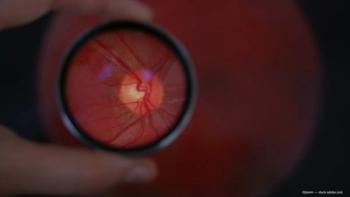
PEX associated with CVD, CVA in meta-analysis
Pseudoexfoliation syndrome (PEX) appears to be significantly associated with both cardiovascular (CVD) and cerebrovascular disease (CVA), according to a new meta-analysis, said Helen Chung, MD.
Seattle-Pseudoexfoliation syndrome (PEX) appears to be significantly associated with both cardiovascular (CVD) and cerebrovascular disease (CVA), according to a new meta-analysis, said Helen Chung, MD.
“The data has been conflicting,” said Dr. Chung, from the University of Alberta, Canada, as to whether PEX was associated with CVD or CVA. “To our knowledge, this is the first meta-analysis.”
PEX syndrome is a systemic disorder with ocular manifestations, and is the most common cause of secondary glaucoma, as well as the most frequent cause of unilateral glaucoma.
Some data indicate that individuals with PEX glaucoma may be at a higher risk of developing CVD and CVA, and Dr. Chung and colleagues conducted a meta-analysis to summarize quantitatively the current body of literature pertaining to this association.
Included in the diagnosis of CVD were coronary artery disease, ischemic heart disease, and angina, while CVA included acute cerebrovascular disease, stroke, and white matter hyperintensities on magnetic resonance imaging.
A total of 13 studies met their inclusion criteria, and spanned global populations. There were 12 studies, with a total of 8,310 individuals with PEX, which evaluated the association with CVD. The summary odds ratio (OR) was 1.46 [1.13-1.89 95% confidence interval], p <0.01). For CVA, using 5 studies with a total of 1,036 PEX patients, the OR was 2.16 [1.16-4.03], p = 0.02. Finally, using all 13 studies for combined vascular events (8,346 PEX patients and 135,570 controls), there was a summary OR of 1.58 [1.31-1.91], p <0.0001.
A mega-regression in the CVD and combined vascular events groups was not significant for age, gender, and study design. It was not possible to do a similar analysis for CVA because there was not enough data available, Dr. Chung said.
“There were limitations to our study,” Dr. Chung said. “All studies were retrospective, and we could not to a mega-regression for CVA.”
But this analysis has important clinical significance, and there is a need for clinical guidelines to address this, as well as prospective studies and a sensitivity analysis, according to Dr. Chung.
For more articles in this issue of Ophthalmology Times Conference Brief,
Newsletter
Don’t miss out—get Ophthalmology Times updates on the latest clinical advancements and expert interviews, straight to your inbox.









































